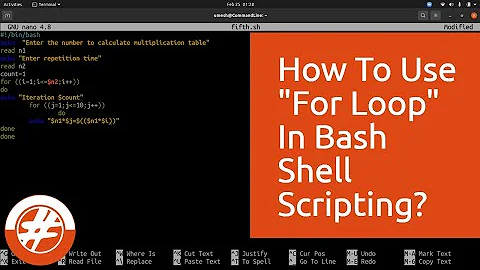Shell script "for" loop syntax
Solution 1
Brace expansion, {x..y} is performed before other expansions, so you cannot use that for variable length sequences.
Instead, use the seq 2 $max method as user mob stated.
So, for your example it would be:
max=10
for i in `seq 2 $max`
do
echo "$i"
done
Solution 2
Try the arithmetic-expression version of for:
max=10
for (( i=2; i <= $max; ++i ))
do
echo "$i"
done
This is available in most versions of bash, and should be Bourne shell (sh) compatible also.
Solution 3
Step the loop manually:
i=0
max=10
while [ $i -lt $max ]
do
echo "output: $i"
true $(( i++ ))
done
If you don’t have to be totally POSIX, you can use the arithmetic for loop:
max=10 for (( i=0; i < max; i++ )); do echo "output: $i"; done
Or use jot(1) on BSD systems:
for i in $( jot 0 10 ); do echo "output: $i"; done
Solution 4
If the seq command available on your system:
for i in `seq 2 $max`
do
echo "output: $i"
done
If not, then use poor man's seq with perl:
seq=`perl -e "\$,=' ';print 2..$max"`
for i in $seq
do
echo "output: $i"
done
Watch those quote marks.
Solution 5
We can iterate loop like as C programming.
#!/bin/bash
for ((i=1; i<=20; i=i+1))
do
echo $i
done
Related videos on Youtube
eykanal
I'm currently working at Google, helping build AI/ML tools for public sector. I've worn a number of hats in the past, including cybersecurity researcher, computational neuroscientist, healthcare technical manager, financial quant, freelance web developer, and IT consultant. I find writing therapeutic; you can read my musings on my blog. Most articles relate to technical management, with the occasional technical discussion. I also find poi spinning to be a pretty awesome hobby as well. You can learn more about me on my LinkedIn page.
Updated on July 22, 2020Comments
-
eykanal almost 4 years
I have gotten the following to work:
for i in {2..10} do echo "output: $i" doneIt produces a bunch of lines of
output: 2,output: 3, so on.However, trying to run the following:
max=10 for i in {2..$max} do echo "$i" doneproduces the following:
output: {2..10}How can I get the compiler to realize it should treat $max as the other end of the array, and not part of a string?
-
whatsisname over 14 yearswhat system and shell are you using? What kind of goofy system has sh or bash, but doesn't have seq, a coreutil?
-
 Rahul Das over 14 yearsFreeBSD doesn't.
Rahul Das over 14 yearsFreeBSD doesn't. -
 a paid nerd over 14 yearsSmall style nit: I usually see the
a paid nerd over 14 yearsSmall style nit: I usually see thedoandthenkeywords on the same line asforandif, respectively. E.g.,for i in {2..10}; do -
Barmar almost 11 yearspossible duplicate of Is it possible to use a variable in for syntax in bash?
-
jrm about 9 yearsFreeBSD, at least 10, does have /usr/bin/seq.
-
Charles Duffy over 3 years@whatsisname,
seqis not POSIX-standardized. Even if it exists, it's not guaranteed to have any particular behavior. There's a reason none of the patterns discussed in wooledge.org/~greybot/meta/counting (the relevant entry in the freenode #bash channel's factoid database) depend on it.
-
-
system PAUSE over 14 yearsseq is relatively new. I only found out about it a few months ago. But you can use a 'for' loop!! The disadvantage of a 'while' is that you have to remember to increment the counter somewhere inside the loop, or else loop downwards.
-
Flow about 12 years
true $(( i++ ))doesn't work in all cases, so most portable would betrue $((i=i+1)). -
system PAUSE about 12 years@Flow: Hm, I just tried it on a couple of systems (Linux and BSD based) with #!/bin/sh and it worked fine. Invoked under bash and specifically under /bin/sh, still worked. Maybe the version of sh matters? Are you on some old Unix?
-
chepner over 10 yearsVery few systems have a dedicated
sh, instead making it a link to other another shell. Ideally, such a shell invoked asshwould only support those features in the POSIX standard, but by default let some of their extra features through. The C-style for-loop is not a POSIX feature, but may be inshmode by the actual shell. -
chepner over 10 yearsA security risk, since
evalwill evaluate anything you setmaxto. Considermax="2}; echo ha; #", then replaceecho hawith something more destructive. -
 logan over 10 yearssemi colon should not come in "for (( i=0; i < max; i++ ));"
logan over 10 yearssemi colon should not come in "for (( i=0; i < max; i++ ));" -
Conrad Meyer about 10 years(S)he set max to 10. No risk.
-
 miller almost 8 yearsThere is no good reason to use an external command such as
miller almost 8 yearsThere is no good reason to use an external command such asseqto count and increment numbers in the for loop, hence it is recommend that you avoid usingseq. This command is left for compatibility with old bash. The built-in commands are fast enough.for (( EXP1; EXP2; EXP3 )) ... -
Wernight over 7 years@miller the
for (( ... ))syntax isn't POSIX and that means for example that it won't work out of the box on things like Alpine Linux.seqdoes. -
 Franklin Yu about 5 years@Wernight Not just Alpine Linux;
Franklin Yu about 5 years@Wernight Not just Alpine Linux;#!/bin/shis Dash in Debian/Ubuntu.





